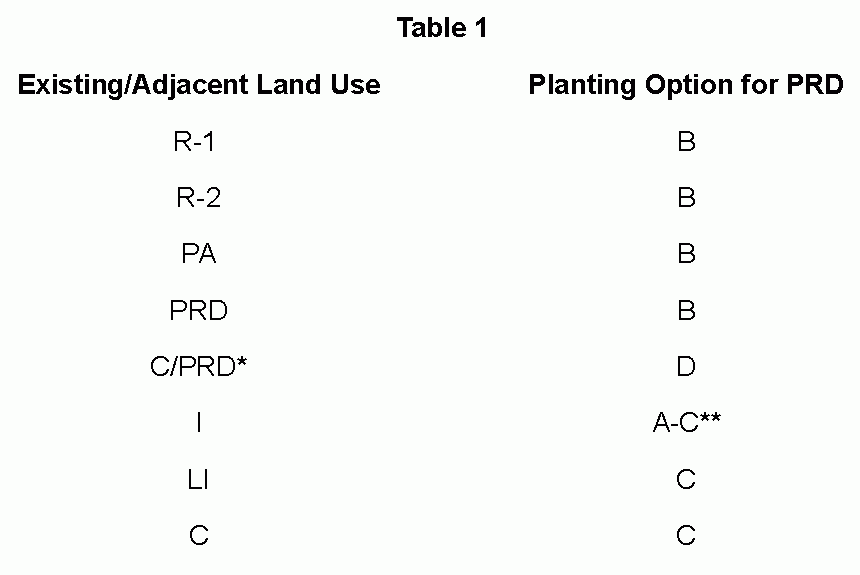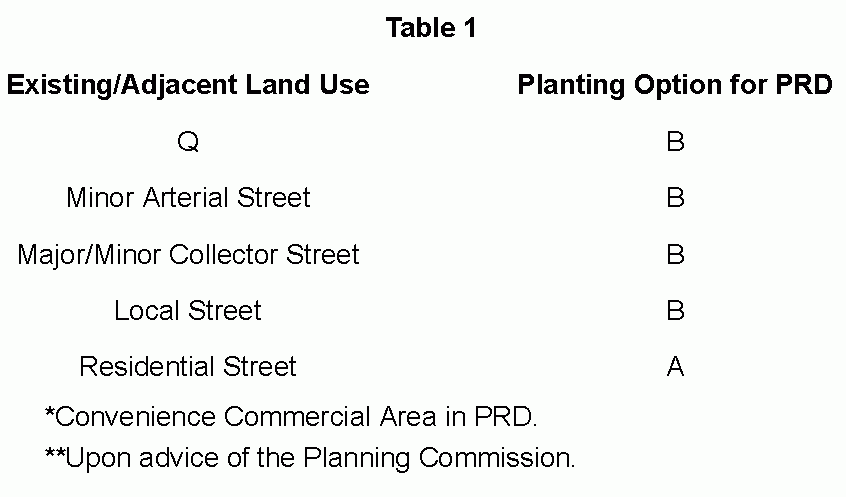M. Landscaping and Buffers.�
(1) General Landscaping.�
(a) The amount, density, and types of plantings shall be based upon physiographic features, proximity of existing dwellings, compatibility of adjacent uses and natural views. Where adjacent property has been developed in such a manner that privacy from the PRD is desirable, the planting strip adjacent thereto shall be of sufficient density and contain sufficient plant material to effectively screen the portions of the PRD from which privacy is desired for all seasons. In other areas, particularly where physiographic or environmental features and existing vegetation provide an attractive setting, the planting strip may be left in its natural state or enhanced with additional plant material of lesser density than a full screen.�
(b) No plantings shall be placed with their center closer than 5 feet from a property line of the tract.�
(c) Plantings shall be permanently maintained and replaced in event of death if necessary to maintain an effective screen in accordance with the management of common open space.�
(d) Disturbed topsoil shall be stockpiled, protected from erosion and replaced after construction.�
(e) Planting and protection of landscape material shall be in accordance with a plan and schedule subject to Township approval, and shall be completed within 6 months of initial occupancy of each stage of development. Maintenance specifications for all plant material shall be submitted as part of the preliminary approval stage.�
(2) Buffers. Buffering serves to soften the outline of buildings, to screen glare and noise, and to create a visual and/or physical barrier between conflicting land uses. The extent of buffering is determined by the type of use proposed and the adjacent uses or streets surrounding the proposed development. The impact of the proposed use on adjoining properties is the basis for establishing buffer and planting strip standards. Staging and timing of buffer planting will be coordinated through consultation and discussion with the Board of Supervisors.�
(a) On the planned residential development tract a 100-foot buffer area is required around the tract's perimeter as it abuts other land uses, and a 50-foot buffer is required along existing public rights-of-way.�
(b) To determine the required buffer area treatment, a three step procedure shall be followed:�
Step 1- Site Analysis and Determination of Buffer Area Class.�
Step 2 - Selection of the Planting Option for the Buffer Class.�
Step 3 - Selection of the Plant Materials from the Plant Materials List.�
(c) Step 1. Site Analysis and Determination of Buffer Area Class.�
1) For each property boundary, the applicant shall identify the adjacent land use or road classification. The land use should be determined by the Township's Zoning Map, on-site survey, and the Highway Classification Section in the Township's Comprehensive Plan. Table 1, following, specifies the buffer area class for each boundary.�
2) The applicant shall match his proposed land use with the corresponding adjacent land use or road classification for each property boundary, as outlined in Table 1. The letter indicates the buffer area class.�
(d) Step 2. Selection of the Planting Option for the Buffer Class.�
1) After determining the buffer class, the applicant shall select a planting option from Table 2. For each buffer class, several planting options are available, one of which the applicant shall select to meet the buffer area requirement for each boundary.�
(e) Step 3. Selection ofPlant Materials from the Plant Materials List.�
1)Each planting option may utilize any of the plant materials outlined in Table 3.�
2) Minimum plant size, given either in height or in caliper, is indicated on this table. The Township Supervisors may permit other planting types if they are hardy to the area, are not subject to blight or disease, and are of the same general character and growth habit as those listed in Table 3. All planting material shall meet the standards of the American Association of Nursureymen.�
3) The applicant may not be required to provide additional buffering or a planting strip should existing plantings, topography, or man-made structures, be deemed acceptable for screening purposes by the Board of Supervisors.�

